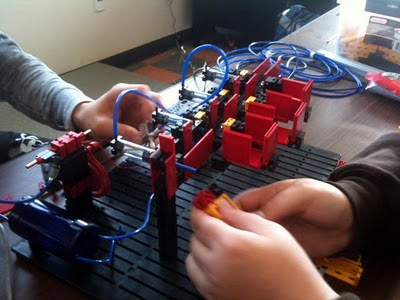
Welcome to our Principles of Engineering Machine Control (Robotics!) Capstone Project for the 2013-14 school year. This is an exciting opportunity to work with your partners to develop a unique solution to an open-ended problem.
You will earn "Achievements" based on both the process you apply and the product you build. The team that earns the most "Achievements" wins!
This project is worth 7 points per week we spend on it and is capped at a maximum of 25 points. The top team will earn 100%. The second place team will earn a 92%. The third place team will earn an 89% and the fourth team will earn 85%.
Process Achievements:Organize it!: Title your post and organize it by section in a logical manner.
Brainstorm!: Provide at least four of your team’s brainstorming ideas for the design solution. This should include brainstorming sketches. Each sketch should include labels and descriptions for communication.
CAD!:
Use our Inventor CAD software to model a prototype or your final design. Post screenshots of your model.
Enter the Matrix: Evaluate your solution ideas (4 minimum) using a decision matrix. Determine the best solution to the problem. Explain your rating system and share insight on why you rated your solutions as you did.
Design Solution: Create a detailed pictorial sketch or use 3D modeling software to document the best solution, based upon your team’s decision matrix. Your sketch or 3D model should include a rationale for the design selected as the final design solution. Each sketch should include labels and descriptions for communication.
"I've Made a Few Special Modifications...": Document modifications made to your design during implementation. Explain the reason for the modifications and describe how the new design solution will solve the problem. "Story" is the split between expectation and outcome. Tell us a story regarding what your plan was and how it actually came out! Use photos and sketches to call out three changes. (Nerd points if you know where the quote for this Achievement title comes from)
Final Implementation: This section will showcase your final hardware and software solution. Include photos of your hardware and program. Call out atleast three key features of your design that were significant to its performance. Report how your solution performed in the challenge.
Final Implementation - Video!: Embed a video that showcases your solution in action!
Reflection: Adress the four feedback types that we use in our courses (+, -, ?, !). Solicit feedback from someone outside of your team as well.
Some questions to consider in this section: How well did you accomplish your objectives? What would your team do differently with your design solution and why? Do the results fulfill the problem statement? Provide a brief explanation of what you learned, the challenges of working in a design team, and the purpose of the design problem.
Reference: Post a hotlink to material you referenced on the internet. Explain why this information is significant to your project.
Product Achievements:Sorting Speed (15 marbels total: at least 3 different types):Process 15 marbles in less than 2:00 minutes.
Process 15 marbles in less than 1:45 minutes.
Process 15 marbles in less than 1:30 minutes.
Process 15 marbles in less than 1:15 minutes.
Process 15 marbles in less than 1:00 minute.
Process 15 marbles in less than 45 seconds.
Process 15 marbles in less than 30 seconds.
Marble Sorting (Must sort at least 3 types. More than 3 types earns you a multiplier on your Sorting Speed achievements):Sort 4 marble types = 2 x earned Sort Speed Achievements.
Sort 5 marble types = 3 x earned Sort Speed Achievements
Marble Delivery (may use non-fischertechnik materials to create a "hopper" to drop marbles into for "Drop" achievements):Drop marbles from 6" above machine
Drop marbles from 1' above machine
Drop marbles from 2' above machine
Drop marbles from 6' above machine
Systems (not including motor or piston used to charge your pressure vessel):Use at least one piston in a pneumatic system
Use at least two pistons in a pneumatic system
Use pneumatics but less than three pistons
Use at least one motor













